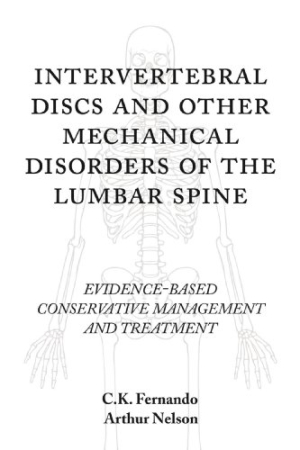Intervertebral Discs and Other Mechanical Disorders of the Lumbar Spine
Evidence-Based Conservative Management and Treatment
Authors make strong case for conservative treatment of back pain, with no rush into surgery.
C. K. Fernando, a practitioner of low back pain treatment, hopes to improve understanding among professionals about the efficacy of various therapies for lumbar spine disorders. “Unfortunately, the term low back pain is an inexact, catch-all category,” Fernando writes in his book, Intervertebral Discs and Other Mechanical Disorders of the Lumbar Spine. “Because the definition is not standardized, many studies of its prevalence, incidence and outcomes are not comparable.”
This forms the basis of his rational guide to treatment, three chapters of which are co-authored with biology/physical therapy professor Arthur Nelson.
Intervertebral discs, which comprise about one-third of the height of the spine, connect the vertebrae to each other and are composed of cartilaginous end plates packed with a gel-like substance that loses its shock-absorbing capacity with age. The lumbar spine (lower back) is strong, made for flexion, extension, and rotation, but it can be damaged by overload and repetitive strain. Diagnosing the precise cause of low back pain is challenging: falling, disease, congenital malformations, postural anomalies, aging, even depression, all can cause spinal problems.
Standard treatments include traction, laser therapy, exercise, heat, and, as a last resort, surgery. Fernando strongly recommends conservative treatment—rest, modification of activity, non-steroidal anti-inflammatory medication, and gentle, staged exercise—after extensive evidence-based diagnosis. He is leery of many commonly applied treatments, particularly surgery, and advocates for the least invasive approaches possible offered in stages and based on clear evidence of need.
In his “Plea for Progress,” Fernando urges using common medical terminology across all disciplines, diagnosing based on “age-old accepted methods of allopathic medicine,” and avoiding oversimplification (calling all back ailments “LBP”). He makes a cogent case that by accepting a “one-size-fits-all” approach, therapists are actually contributing to the explosion of back surgeries and other invasive treatment methods.
The book is divided into nine chapters that move through the analysis of the structure of the lumbar spine to various common disorders to Fernando’s recommended clinical evaluation techniques and physical therapies. The volume also includes drawings of anatomical structures and therapeutic exercises.
The style is spare and the text well proofed, although the front cover is bland and the back cover is crowded with material presented in a small, hard-to-read font. Eleven black-and-white photographs showing steps in an EMG test are so grainy that much of the information is nearly unreadable. This is curiously at odds with content urging the setting of more exacting standards. To judge by the copious endnotes after each chapter, a great deal of research went into the book’s creation. Significantly, though, almost no dates of cited source materials are later than 2002, with most clustered in the 1990s.
The book’s target audience—educators and clinicians concerned with lumbar spine injury and treatment—will doubtless be conversant with the terms and issues presented here. However, such professionals may be put off by the lack of current source material and the claim expounded on the back cover of the book: “this might be the only book written by two physical therapists for the treatment of patients suffering low back problems, with evidence to back it up.” This statement suggests a zeal not in keeping with the book’s purported scientific stance.
Fernando and Nelson have gotten their message out, and it is likely an audience of their peers that will judge how successfully they have made their case for the conservative treatment of low back pain.
Reviewed by
Barbara Bamberger Scott
Disclosure: This article is not an endorsement, but a review. The publisher of this book provided free copies of the book and paid a small fee to have their book reviewed by a professional reviewer. Foreword Reviews and Clarion Reviews make no guarantee that the publisher will receive a positive review. Foreword Magazine, Inc. is disclosing this in accordance with the Federal Trade Commission’s 16 CFR, Part 255.

